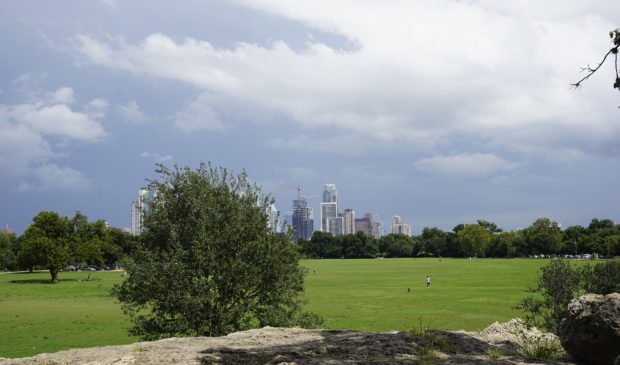Summer pilot aims to save Zilker from parking overload
Tuesday, April 16, 2019 by
Ryan Thornton The first piece of a long-term effort to systematically rethink Zilker Park’s parking, transportation and environmental needs may come into play this summer with a short-term transportation pilot program aiming to reduce traffic and parking demand in and around the park.
Pending action by City Council, the pilot would include a number of suggestions generated over the past few months by the Short-Term Transportation Solutions subgroup of the larger Zilker Park Working Group, formed by Council last June as part of the preliminary step to creating a harmonious Zilker Park Master Plan.
Such a pilot was initially slated for last fall, but was rescheduled for May to give the subgroup adequate time to research and deliberate over possible short- and long-term transportation solutions. The result of those discussions, a list of seven short-term recommendations, was edited and approved by the working group on March 25.
The recommendations are generally designed to provide immediate relief by making use of existing resources and infrastructure when possible. That includes efforts like partnering with nearby parking facilities along MoPac Expressway, introducing parking fees along Azie Morton Road during peak times and carving out space in the right of way along Barton Springs Road from Lamar Boulevard to implement temporary protected bike lanes.
Topping the list is a recommendation for a new shuttle pilot service connecting the park and one or more possible park-and-ride locations such as Camp Mabry, Highland Mall or Capital Metropolitan Transportation Authority’s new Westgate Transit Center in South Austin. The shuttle could also service parking areas closer to the park, like those beneath and adjacent to MoPac.
According to the recommendation, this summer’s shuttle pilot would begin no later than Memorial Day weekend and continue through Labor Day weekend, operating at varying frequencies of service depending on the time of week and demand from special events. The working group also recommends the shuttle have the capacity to accommodate pets and park accessories like coolers and baby strollers, and be free of charge, or include entrance to Zilker Botanical Garden and Barton Springs Pool.
In addition to the shuttle service, the recommendation suggests partnering with Capital Metro to temporarily boost its frequency of route 30, which connects downtown to the Westgate Transit Center via Barton Springs Road, to run every 15 minutes, with the possibility of making the change permanent if the pilot is successful.
Angela Richter, chair of the transportation subgroup, told the Monitor that Capital Metro initially provided a presentation to the group last fall, but had not been part of the group’s conversations or confirmed interest in participating in the pilot program since then.
The group also suggests improving active transportation by providing designated scooter and bike rental and bike parking facilities at adjacent bus stops and throughout the park during the pilot period and placing wayfinding signs with travel time estimates to common destinations throughout the park.
In the long term, as the working group’s two other subgroups prepare their own recommendations regarding the Butler Landfill along Stratford Drive and the Polo Fields on the northern side of Barton Springs Road, the transportation subgroup suggests the city consider various permanent changes in drafting a master plan.
The transportation subgroup is asking the city to look at introducing an internal shuttle circulator inside the park (possibly making better use of the Zilker Zephyr in doing so), constructing a parking garage within or near the park to reduce total impervious cover, converting Lou Neff Road and Columbus Drive to shared-use paths for bikes and pedestrians, and connecting the northern and southern portions of the park across Barton Springs Road via pedestrian bridge or by directing the road underground as it intersects with the park.
A comprehensive set of recommendations is being finalized and will be submitted to Council by May 1.
Photo by Spawnzilla [CC BY-SA 4.0], via Wikimedia Commons.
The Austin Monitor’s work is made possible by donations from the community. Though our reporting covers donors from time to time, we are careful to keep business and editorial efforts separate while maintaining transparency. A complete list of donors is available here, and our code of ethics is explained here.
You're a community leader
And we’re honored you look to us for serious, in-depth news. You know a strong community needs local and dedicated watchdog reporting. We’re here for you and that won’t change. Now will you take the powerful next step and support our nonprofit news organization?



